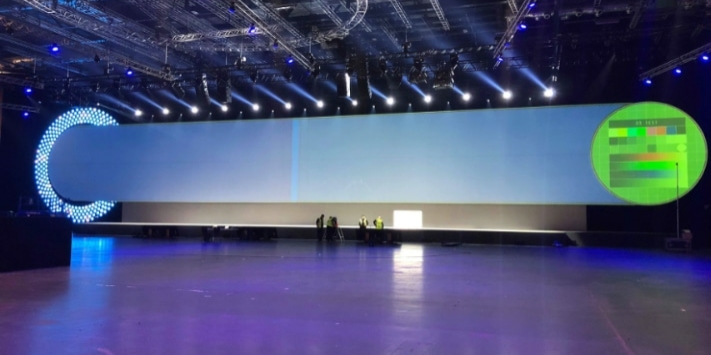What is rear projection?
Rear projection refers to a set-up where the projector is located behind the screen, casting light onto the back of the screen for the audience to view from the front.
This method can often create a higher quality image than front projection, and, with the projector tucked behind the screen, can offer a neater set-up. Rear projection is often used in professional and commercial environments, where there is plenty of room to account for this type of set-up.
How do rear projection screens work?
So, how do rear projection screens work? They work by shining and filtering light through a lens, which is cast onto the screen. With rear projection, the image is cast onto the back of a screen. The specialist screen diffuses the light through the material to produce a high image quality on the front.

Things to keep in mind before investing in a setup for a rear projector screen.
Whilst deciding on the right type of projection set-up for your event, it is worth considering these four critical factors of rear projection.
Screen material
Although your projector can be used for both front and rear projection, a specialist screen is required for rear projection. This is because the material for rear projection needs to be semi-translucent in order to diffuse the light, rather than reflect light for front projection. Rear projection screens are often grey in appearance.
Viewing angles
You should also consider the angles your audience will be viewing the screen from when using rear projection. Whilst rear projector screens eradicate the possibility of audiences obstructing the projection and casting shadows on the screen, this set-up is best viewed straight on. If your audience is encircling the front of the screen, those with the widest viewing angles will receive a worse-quality image than those sitting facing the screen straight on.
Lighting
When projecting, high ambient lighting can reduce the perceived brightness of the projected image, so the lighting of the room is a factor to consider. However, rear projection screens do absorb ambient lighting better than if you were using front projection screens.
Projector power
Rear projection requires a powerful projector, since the screen still does reflect some light. This means the projector needs to counteract any reflected light which is directed towards it in order to cast a high-quality image.

What is the required space for a rear projection setup?
Due to their set-up, rear projectors do require more space than front projectors. Unlike front projection, the space used to house the projector cannot be used to seat audiences and the space between the projector and the screen cannot be obstructed with storage.
The projector's lens type and screen size affect the distance between the projector and the screen. A standard lens typically requires a distance of between 1.5 and 2 times the width of the screen being used.
IMA is an expert in rear screen setup and our experienced team, with a track record of hundreds of successful projects, is available to consult and assist you in setting up the projection screen for your event and venue. To create a memorable and impactful event for your audience, don't overlook the importance of visual elements. Contact our specialist team today for a successful event outcome.